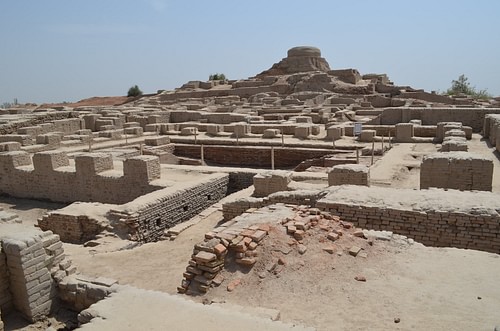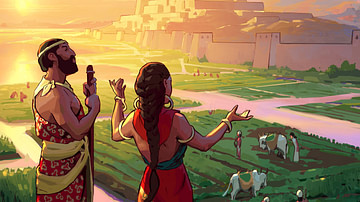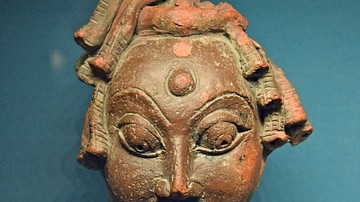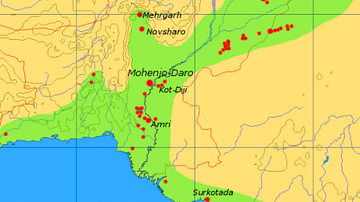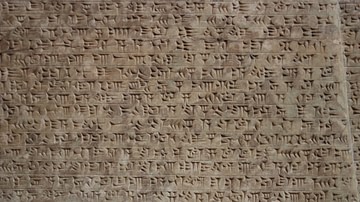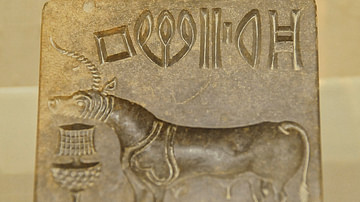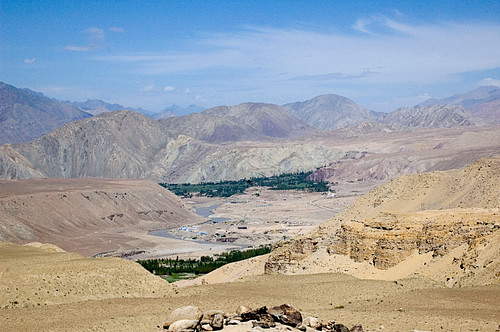
Aryan is a designation originally meaning “civilized”, “noble”, or “free” without reference to any ethnicity. It was first applied as a self-identifying term by a migratory group of people from Central Asia later known as Indo-Iranians (who settled on the Iranian Plateau) and, later, applied to Indo-Aryans (who traveled south to settle northern India).
The word had no widespread ethnic connotation prior to the 19th century CE other than its usage by the Persians (known as 'Iranians' from 'Aryans') to distinguish themselves from their Muslim Arab conquerors in the 7th century CE, and even then (it could be argued) it was not so much an ethnic distinction as one of class and personhood. Prior to the conquest, Persia had been “the land of the Aryans” and, afterwards, a term was coined for non-Aryans.
'Aryan' became associated with ethnicity and, especially, with light-skinned (Caucasian) superiority, only after Western European scholars began translating, and often misinterpreting, Sanskrit texts in the 18th and more extensively in the 19th centuries CE. Theories had been advanced earlier regarding a correlation between Sanskrit and European languages, but this concept was popularized by the Anglo-Welsh philologist Sir William Jones (l. 1746-1794 CE) in 1786 CE who claimed there was a common source for these languages which he called Proto-Indo-European.
Jones' claim inspired later writers to identify this “common source” and encouraged the French elitist Joseph Arthur de Gobineau (l. 1816-1882 CE) to develop the racist theories concerning “Aryan Blood” and White Supremacy which would become popularized in Germany through the works of Houston Stewart Chamberlain (l. 1855-1927 CE), the British-born political philosopher who would become Adolf Hitler's mentor and inspiration as well as informing the ideology and work of Alfred Rosenberg (l. 1893-1946 CE) which empowered the Nazi Party in Germany c. 1930-1945 CE.
Jones' claim would also influence the work of the German philologist Max Muller (l. 1823-1900 CE) who, in attempting to identify this “common source” via the Rig Veda and the history of the Indus Valley Civilization, created the myth of an Aryan Invasion of the region which claimed light-skinned Aryans conquered darker-skinned indigenous people and established high civilization; an interpretation of his work which Muller himself never intended and, in fact, repudiated.
The work of Gobineau, Chamberlain, and the Aryan Invasion claim would be embraced by the British throughout the 19th and 20th centuries CE to justify their control of India as they were the “Aryans” – a superior race – who were bringing culture and civilization to the less fortunate. This view was encouraged and popularized by the work of the British archaeologist Sir Mortimer Wheeler (l. 1890-1976 CE) who excavated the ancient Indus Valley Civilization cities of Harappa and Mohenjo-daro and claimed his finds supported Muller's Aryan Invasion theory. Just as the fair-skinned Aryans of old had brought civilization to India, Wheeler claimed, so now had the British.
Most of Wheeler's work has been discredited in the modern day, as has Muller's invasion theory, and the works of every contributor to a definition of Aryan as referencing Caucasian have equally been dismissed as either misguided, misinterpretations, or intentionally racist. In the present day, the term is understood to properly refer to the early Indo-Iranian and Indo-Aryan migratory group, possibly originally from the region of the Ural River or, according to some scholars, to the Indo-Iranians only based on the continued usage of the term by the great Persian Empires of the Near East.
Early Migration & Origin of Term
It is thought that the migratory band of peoples later referred to as Indo-Iranians and Indo-Aryans came originally from the area of modern-day Kazakhstan near the Ural River and moved slowly toward the Iranian Plateau where they arrived sometime prior to the 3rd millennium BCE. Whatever they may have called themselves at this time is unknown, but they would later self-reference as Aryans, designating a class of people who were free, noble, and civilized as contrasted with those who did not share their values. There is no evidence of a racial difference, only a class difference. The term seems to have been used in the same way one today might differentiate between high or low-class individuals. Scholar Kaveh Farrokh comments:
The word Aryan means “noble”, “lord”, or “freeman” in Old Iranian languages and has very little to do with Eurocentric doctrines of Nordic racial supremacy, these being first formulated by 19th century racialist philosophers such as Chamberlain. The archaeologist J.P Mallory states that, “as an ethnic designation the word [Aryan] is most properly limited to the Indo-Iranians, and most justly to the latter where it still gives its name to the country Iran…the great Persian king Darius describes himself as Aryan”…The name “Iran” (lit. Land of Aryans) is derived from Aryanam (the plural form in Avestan). (17)
Avestan is the Early Iranian language in which the Zoroastrian scriptures, the Avesta, are written, the earliest source for the origin and meaning of the term Aryan. That which is worth hearing and remembering in the Avesta is referred to as arya; one who hears, remembers, and acts on these worthy precepts is an Aryan. Zoroastrianism developed, in part, from the Early Iranian Religion and retained various aspects of it, so, most likely, the term was used the same way prior to the time of Zoroaster (1500-1000 BCE) to mean one who adhered to the path of Light rather than Darkness.
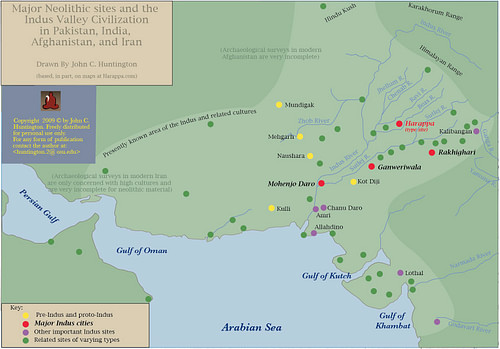
The same meaning of the term was understood in India where it appears in the texts of Hinduism, Buddhism, and elsewhere. Scholar Jeffrey D. Long provides the standard Hindu definition of Aryan as:
Noble, cultured, “gentleman”, a term by which ancient Vedic peoples referred to themselves and their cultural and religious practices (in contrast with mleccha, or “barbarian”). It does not appear that the term arya had any ethnic or racial connotations until 19th century European scholarship thus interpreted it, on the false assumption of a correlation between culture and ethnicity. The term refers not to ethnic characteristics, but to cultural and spiritual ones. (60)
Further commenting on the ancient meaning of the term, scholar John Keay cites the Indian historian Romila Thapar's informed opinion that “it is doubtful whether the term arya was ever used in an ethnic sense” (19). Scholars Robert E. Buswell Jr. and Donald S. Lopez Jr. note that, in Buddhism, arya retains the Persian meaning of “noble” or “superior” (64), and scholar John M. Koller agrees, writing of the Buddha's concept of the Four Noble Truths, “This fourfold truth is called “noble” (arya) meaning that it is worthy of assent and respect because it is supremely valuable” (53). It is no surprise that this term should mean the same thing in two different cultures because both share many common cultural aspects.
Migration & the Indus Valley Civilization
At some point, the so-called Indo-Aryans of the original migratory group went south toward India where they are thought to have merged with the indigenous people of the Indus Valley Civilization (also known as the Harappan Civilization or Harappan Culture, c. 7000 - c. 600 BCE). This civilization was highly advanced as evidenced by Neolithic sites such as Mehrgarh, occupied prior to 7000 BCE, whose populace developed agricultural techniques, religious rituals, domestication of plants and animals, and produced impressive artistic works.
By c. 2600 BCE, the great cities of Harappa, Mohenjo-daro, Ganeriwala, and over 1,000 others had risen, the ruins of which give evidence of advanced urban planning and technological skill. These cities had running water and a highly developed sewer and drainage system which directed rainwater or waste toward fixtures on either side of the streets. Homes were constructed in such a way as to cut down on outside noises and were built with “wind catchers” which provided air conditioning within; a luxury not even Rome, at its height, developed. The people of the Indus Valley also created a writing system (as yet undeciphered), musical instruments, farming implements, and large, flat-bottomed boats. Ports were constructed with great warehouses for goods and trade was conducted with a number of other nationalities, notably the people of Mesopotamia and Egypt.
At some point between c. 1900 - c. 1500 BCE, the Indus Valley Civilization began to decline. Cities were abandoned and there was a significant migration of the people toward the south of the subcontinent. This period of migration and change coincides with the development of Vedic thought and the so-called Vedic Period (c. 1500 - c. 500 BCE) when the Vedas, the sacred texts of Hinduism, were committed to written form in Sanskrit. Since the people of the Indus Valley Civilization did not write in Sanskrit, this language – and the concepts it expressed in the scriptures – had to have come from somewhere else. It is thought that they arrived with an Indo-Aryan migration, perhaps many and over a number of years, and the cultures of the two peoples then blended. Koller writes:
The Vedic age began when the Sanskrit-speaking peoples began to dominate life and thought in the Indus Valley, probably between 2000 and 1500 BCE. Historians used to think that these Sanskrit-speaking peoples who called themselves Aryans came to the Indus valley in northwest India as conquerors some thirty-five hundred years ago. But recent scholarship has challenged this thesis of conquering Aryans. What we do know is that the earlier Indus culture, which flourished from 2500 to 1500 BCE, and which, judged by its archaeological remains, was quite sophisticated, declined at this time. We also know that the Vedic thought and culture reflected in the Rig Veda has a continuous history of dominance in India during the last thirty-five hundred years. It is likely that the cultural traditions of the Vedic peoples mingled with the traditions and customs of the Indus people. (5)
A counterview to the above is the so-called Out of India Theory (usually given as OIT) which claims that Vedic thought, and Sanskrit, developed in the Indus Valley, was exported to Central Asia, and then returned with a migratory wave. This theory has been rejected by mainstream scholarship and is advanced, almost always, by those with a nationalist agenda. It is understandable, however, how one would support such a view when, for well over 100 years, Western scholarship has regularly attributed one's cultural achievements to others.
The migration of the Indus Valley inhabitants to the south is well established but there is no need to assume that some invading force drove the relocation. It was most likely due, not to any new arrivals, but to climate change, drought, and decline in trade with Mesopotamia and Egypt, both distracted by domestic affairs. The Indus Valley Civilization's decline corresponds to the Middle Bronze Age in Mesopotamia (2119-1700 BCE) during which the Sumerians were busy driving out the Gutians, Hammurabi of Babylon was conquering cities, and the Hittites were invading. In Egypt, the Middle Kingdom (2040-1782 BCE) had begun to decline after the reign of Sobekneferu (c. 1807-1802 BCE) and this was hastened by the weak 13th Dynasty which lacked the bureaucratic skills and administrative strength of its predecessor.
Long-distance trade became more difficult for the merchants of these regions during this time and that would no doubt have contributed to the decline of the Indus Valley Civilization which relied on such trade. The people did not move south to run from anything; they moved south toward better living conditions and opportunity. The cities were abandoned, not because of invasion, but due to overuse of resources and, most likely, overpopulation.
Racial Reinterpretation
When the ruins of the city of Harappa were discovered by the explorer Charles Masson (pseudonym of the British soldier and scholar James Lewis, l. 1800-1853 CE) in 1829 CE, no one knew this civilization had ever existed and later, applying the racial theories which had developed, Western scholars concluded that there had been a massive Aryan Invasion which destroyed the cities and drove the survivors south. Nothing was known of the Indus Valley Civilization when Sir William Jones published his Proto-Indo-European theory of language in 1786 CE and, had it been known, it would have no doubt been attributed to the work of some other, supposedly, light-skinned race in the same way later Western archaeologists and scholars would claim the Egyptians were Caucasian and that the Maya of Mesoamerica were, somehow, a colony of Egypt.
The kind of systemic racism which led to these conclusions cannot be traced to a single individual, but the association of Aryan with White Supremacy can. Joseph Arthur de Gobineau was a would-be scholar and fiction writer from an aristocratic French family who, though poor himself and constantly struggling to make a living, still considered himself superior to others. He published his work An Essay on the Inequality of the Human Races in 1855 CE in which, among other racist claims, he insisted that the term Aryan applied to light-skinned Europeans who had “Aryan blood” and were superior to others of darker complexion who did not.
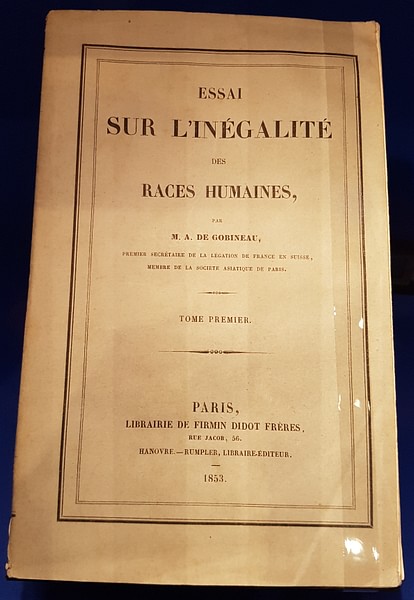
Gobineau became an ardent admirer of the German composer Richard Wagner (l. 1813-1883 CE) who, he discovered, had read his book and admired him as well. Gobineau became a member of Wagner's Bayreuth Circle and so did another Wagner enthusiast and ardent racist, Houston Stewart Chamberlain, who would eventually become Wagner's son-in-law. Chamberlain further associated Aryan with ethnicity in his work, claiming that Caucasians had established all the great civilizations in the world. This view is generally cited as contributing to the formulation of the Aryan Invasion Theory and, perhaps, it did but, if so, it does not seem to have been intentional on the part of Max Muller.
Although Muller is routinely cited as the “author” of the Aryan Invasion Theory, he actually only gave a name to what men like Gobineau and Chamberlain already believed. Muller himself never advocated for the claim that Aryan had anything to do with ethnicity but based his theory of an invasion of India by a northern people on his interpretation of the Rig Veda, oldest of the Vedas, parts of which suggested this possibility to him. It is unfortunate, actually, that Muller's name must be routinely associated with those of racists and antisemites as he himself was neither and believed in racial equality.
The works of Gobineau and Chamberlain would inspire and encourage Hitler and his ideological architect Alfred Rosenberg to establish the Nazi Party in Germany and set the country on its course toward World War II and the Holocaust. After Germany's defeat in 1945 CE, their works were discredited and rejected by most mainstream scholars but, in often watered down and diffused academic language, still appeared – and continue to appear – in scholarly works on the history and cultural development of the Indian subcontinent. These theories were further popularized through the work of Sir Mortimer Wheeler, a highly respected archaeologist and scholar who excavated the sites of Harappa and Mohenjo-Daro between 1944-1948 CE, interpreted his finds in light of racialist theories, and certified the Aryan Invasion Theory as well-established history.
Conclusion
In the 1960s CE, however, Wheeler's claims – which rested largely on skeletons found during his excavations which he claimed presented evidence of violent death in battle – were refuted, thanks largely to the work of the American scholar and archaeologist George F. Dales (Keay, 23). Dales found no evidence at any of the ancient sites to support the claims of invasion and conquest and neither has anyone else since. In the present day, the Aryan Invasion Theory has been discredited and is only advanced by those pushing a racialist or nationalist agenda.
The old theory, still taught in high school and university classes - in the United States at least - until fairly recently, which maintained a vision of light-skinned Aryans conquering dark-skinned Dravidians has been replaced by the far more informed and realistic understanding of a migration pattern and blending of cultures. John Keay comments:
Perhaps some of the Aryan clans were invited into India as allies, mercenaries, or traders; the indigenous [people] may not have been 'Dravidians' but earlier Indo-Aryan arrivals; there is nothing to suggest that [the Aryans] ever constructed 'castles and cities' [as some have claimed] and the archaeological evidence, being almost entirely ceramic, gives no hint of the sudden change one would expect from the conquest and suppression of an entire nationality…Arguably [the] process of Aryanization by which arya culture spread to non-arya peoples continued throughout the subcontinent's history, indeed, is still going on to this day. (28)
Keay also notes that the people of the Indus Valley Civilization gave as much as they received, culturally, from the Aryan migrants and the relationship was mutually beneficial (24-26). The unfortunate association of the term 'Aryan' with the misguided and ignorant concept of White Supremacy continues in the present day but it is hoped that, in time, that will change just as racialist definitions and interpretations of the past have, and 'Aryan' will again assume its original meaning in defining one who is noble, who recognizes that which is worth hearing and remembering for one's own and the greater good, and is therefore civilized. At the same time, the definition of 'Aryan' might be expanded and enlarged, in a universal sense, to include anyone – of any skin color, class, or cultural affiliation - who respects and acknowledges the inherent human dignity and rights of any other.
